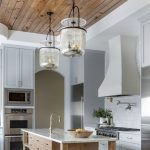
Pendant lamps have become increasingly popular in kitchen design in recent years. These stylish and versatile lighting fixtures not only provide functional lighting but also add a touch of elegance and sophistication to any kitchen space. Pendant lamps are suspended from the ceiling by a cord, chain, or rod, and typically feature a single light source enclosed in a decorative shade or glass globe.
The importance of lighting in kitchen spaces cannot be overstated. A well-lit kitchen is not only more visually appealing but also more functional and safe. Pendant lamps offer a unique combination of style and functionality, making them an ideal choice for kitchen lighting.
Key Takeaways
- Pendant lamps are a stylish addition to any kitchen.
- They offer both style and functionality, providing task lighting and enhancing the overall aesthetic of the space.
- When choosing pendant lamps, consider size, style, and material to ensure they complement your kitchen design.
- There are various types of pendant lamps available, from classic to contemporary, to suit different tastes and preferences.
- Installing pendant lamps in your kitchen is easy with a step-by-step guide, and they can be used to maximize space and create a statement piece in both small and large kitchens.
The Benefits of Pendant Lamps in Your Kitchen: Style and Functionality
One of the main benefits of pendant lamps in the kitchen is their ability to enhance the overall look and feel of the space. Pendant lamps come in a wide variety of styles, shapes, and sizes, allowing you to choose a design that complements your kitchen decor. Whether you prefer a sleek and modern look or a more traditional and rustic aesthetic, there is a pendant lamp out there for you.
In addition to their style-enhancing capabilities, pendant lamps also offer practical benefits. They provide focused task lighting, making it easier to see and work on specific areas of the kitchen, such as the countertop or stove. Pendant lamps can also be used to create ambient lighting, which helps to create a warm and inviting atmosphere in the kitchen.
Choosing the Right Pendant Lamps for Your Kitchen: Size, Style, and Material
When selecting pendant lamps for your kitchen, there are several factors to consider. First and foremost, you need to determine the appropriate size of the pendant lamps based on the size of your kitchen and the height of your ceiling. A general rule of thumb is to choose pendant lamps that are one-third to two-thirds the width of the surface they are illuminating.
Next, consider the style of the pendant lamps and how they will fit in with your existing kitchen decor. If you have a modern kitchen, you may want to opt for sleek and minimalist pendant lamps with clean lines and metallic finishes. On the other hand, if you have a rustic or farmhouse-style kitchen, pendant lamps made from natural materials like wood or rattan may be more suitable.
Lastly, consider the material of the pendant lamps. Common materials include glass, metal, and fabric. Glass pendant lamps can create a more modern and sophisticated look, while metal pendant lamps can add an industrial touch to your kitchen. Fabric pendant lamps can soften the overall aesthetic and add a cozy feel to the space.
Types of Pendant Lamps: From Classic to Contemporary
| Type of Pendant Lamp | Description | Price Range | Material |
|---|---|---|---|
| Classic Pendant Lamp | A timeless design that adds elegance to any room. | 50-200 | Brass, Glass, Crystal |
| Industrial Pendant Lamp | A rustic and edgy design that complements modern interiors. | 30-150 | Metal, Concrete, Glass |
| Modern Pendant Lamp | A sleek and minimalist design that adds a contemporary touch to any space. | 100-500 | Aluminum, Steel, Glass |
| Tiffany Pendant Lamp | A colorful and intricate design that adds a touch of artistry to any room. | 150-1000 | Stained Glass, Bronze |
There are many different types of pendant lamps available on the market, ranging from classic designs to more modern and contemporary options. Classic pendant lamps often feature ornate details and intricate patterns, making them a great choice for traditional or vintage-inspired kitchens. These timeless designs can add a touch of elegance and sophistication to any space.
On the other end of the spectrum, contemporary pendant lamps are characterized by their sleek and minimalist designs. These modern fixtures often feature clean lines and geometric shapes, making them perfect for modern or minimalist kitchens. Contemporary pendant lamps can create a sense of simplicity and sophistication in any kitchen space.
Some popular styles of pendant lamps include drum pendants, globe pendants, lantern pendants, and mini pendants. Drum pendants feature a cylindrical shade that provides a soft and diffused light. Globe pendants have a spherical shape and provide a more focused light source. Lantern pendants have an open frame design and can add a touch of vintage charm to your kitchen. Mini pendants are smaller in size and are often used in clusters to create a dramatic effect.
How to Install Pendant Lamps in Your Kitchen: A Step-by-Step Guide
Installing pendant lamps in your kitchen can be a relatively simple process if you follow the right steps. Here is a step-by-step guide to help you install pendant lamps in your kitchen:
1. Gather the necessary tools and materials: You will need a ladder, a screwdriver, wire strippers, wire connectors, and a voltage tester.
2. Turn off the power: Before starting any electrical work, make sure to turn off the power to the area where you will be installing the pendant lamps. This can be done by flipping the corresponding circuit breaker in your electrical panel.
3. Remove the existing light fixture: If you already have a light fixture in place, you will need to remove it before installing the pendant lamps. This can usually be done by unscrewing the mounting screws and disconnecting the wires.
4. Install the mounting bracket: Attach the mounting bracket to the electrical box in the ceiling using the provided screws. Make sure it is securely fastened.
5. Connect the wires: Strip about half an inch of insulation from the ends of the wires coming out of the ceiling and from the pendant lamp. Connect the corresponding wires using wire connectors, making sure to match the black wire with black, white with white, and green or bare copper with green or bare copper.
6. Attach the pendant lamp: Once the wires are connected, attach the pendant lamp to the mounting bracket using the provided screws or other hardware.
7. Test the installation: Turn on the power and use a voltage tester to ensure that there is electricity flowing to the pendant lamps. If everything is working properly, you can proceed to adjust the height and position of the pendant lamps as desired.
Pendant Lamps for Small Kitchens: Maximizing Space and Style

Pendant lamps can be a great addition to small kitchen spaces as they can help maximize both functionality and style. In small kitchens, it is important to choose pendant lamps that are proportionate to the size of the space. Opt for smaller pendant lamps or mini pendants that won’t overwhelm the room.
To maximize space, consider installing pendant lamps above the kitchen island or dining area. This not only provides task lighting for food preparation and dining but also creates a focal point in the room. Choose pendant lamps with a slim profile or a vertical design to draw the eye upward and create the illusion of height.
In terms of style, small kitchens can benefit from pendant lamps with clean lines and simple designs. Avoid overly ornate or bulky pendant lamps that can make the space feel cramped. Instead, opt for pendant lamps with a minimalist aesthetic that will blend seamlessly with the rest of the kitchen decor.
Pendant Lamps for Large Kitchens: Creating a Statement Piece
In large kitchen spaces, pendant lamps can be used to create a statement piece and serve as a focal point in the room. Large kitchens often have high ceilings and ample space, allowing for more dramatic lighting fixtures. Consider choosing pendant lamps with larger shades or multiple light sources to fill the space and make a bold statement.
When selecting pendant lamps for large kitchens, you can be more adventurous with your choices. Don’t be afraid to choose pendant lamps with unique shapes, colors, or materials that will stand out and add visual interest to the room. Large kitchens can handle more elaborate designs, so feel free to experiment with different styles and textures.
To create a cohesive look in a large kitchen, consider installing multiple pendant lamps in a row or cluster. This not only provides ample lighting but also adds visual impact and creates a sense of balance in the space. Make sure to space the pendant lamps evenly and at an appropriate height to ensure proper illumination and functionality.
Pendant Lamps for Different Kitchen Styles: Modern, Rustic, and Traditional
Pendant lamps can be incorporated into different kitchen styles, including modern, rustic, and traditional designs. The key is to choose pendant lamps that complement the overall aesthetic of the kitchen and enhance the desired style.
For modern kitchens, pendant lamps with sleek and minimalist designs are a great choice. Look for pendant lamps with clean lines, geometric shapes, and metallic finishes. These contemporary fixtures will add a touch of sophistication and elegance to your modern kitchen.
In rustic or farmhouse-style kitchens, pendant lamps made from natural materials like wood, rattan, or wrought iron can help create a cozy and inviting atmosphere. Look for pendant lamps with warm tones and textured finishes that will blend seamlessly with the rustic decor.
For traditional kitchens, pendant lamps with ornate details and classic designs are a perfect fit. Look for pendant lamps with intricate patterns, decorative shades, and antique finishes. These timeless fixtures will add a touch of elegance and charm to your traditional kitchen.
DIY Pendant Lamps: A Budget-Friendly Option for Your Kitchen
If you’re on a budget or looking for a more personalized touch, DIY pendant lamps can be a great option for your kitchen. Making your own pendant lamps allows you to customize the design, size, and materials to fit your specific needs and style preferences.
To create your own DIY pendant lamps, you will need some basic materials such as lamp cord kits, lampshade frames, light bulbs, and decorative materials like fabric or paper. There are many online tutorials and resources available that provide step-by-step instructions on how to make different types of pendant lamps.
The benefits of DIY pendant lamps go beyond cost savings. By making your own pendant lamps, you have the opportunity to create unique and one-of-a-kind pieces that reflect your personal style and taste. DIY pendant lamps can also be a fun and creative project that allows you to unleash your inner artist.
Maintenance and Care for Your Pendant Lamps: Keeping Them Shining Bright
To ensure that your pendant lamps stay in top condition and continue to shine bright, it is important to properly maintain and care for them. Here are some tips for maintaining and caring for your pendant lamps:
1. Regularly dust and clean the pendant lamps: Use a soft cloth or duster to remove dust and debris from the surface of the pendant lamps. For glass or metal pendant lamps, you can also use a mild glass cleaner or metal polish to keep them looking shiny and new.
2. Check and tighten the screws: Over time, the screws that hold the pendant lamps in place may become loose. Periodically check and tighten the screws to ensure that the pendant lamps are securely fastened to the ceiling.
3. Replace burnt-out light bulbs: If a light bulb in your pendant lamp burns out, make sure to replace it with a new one of the same wattage and type. Follow the manufacturer’s instructions for replacing light bulbs and make sure to turn off the power before doing any electrical work.
4. Inspect the wiring: Periodically inspect the wiring of your pendant lamps for any signs of damage or wear. If you notice any frayed wires or loose connections, it is important to have them repaired or replaced by a qualified electrician.
5. Keep an eye out for common issues: Common issues with pendant lamps include flickering lights, dimming lights, or lights that won’t turn on at all. These issues can be caused by a variety of factors, including faulty wiring, loose connections, or worn-out light bulbs. If you experience any of these issues, it is best to consult a professional electrician for proper diagnosis and repair.
By following these maintenance tips and taking proper care of your pendant lamps, you can ensure that they stay in top condition and continue to provide beautiful lighting in your kitchen for years to come.







